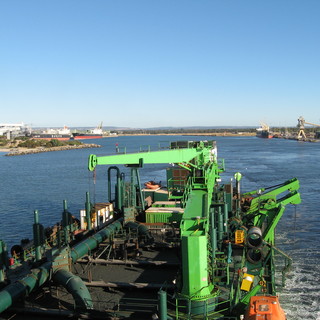
Cape Lambert Port B - Capital Dredging Works
We have been involved in a variety of tasks related to the expansion of facilities at Cape Lambert in order to increase the iron ore output capacity at the port.
Rio Tinto Iron Ore is currently undertaking an expansion of the Cape Lambert port facility, which will increase the port's capacity from 80 million tonnes to 183 million tonnes by 2015. This project is part of Rio Tinto’s current plans to increase their annual capacity in the Pilbara region to 353 Mtpa, making this the largest mining project ever undertaken in Australia.
The expansion of the Cape Lambert port will be achieved through the construction of a new 1.8 km jetty and four-berth wharf to run parallel to the existing wharf.
The building of the new facility requires a capital dredging programme of more 3.5 Mm3 of material from the new berth pockets, turning basin and shipping channel, as well as significant marine and on-shore construction works.
We were engaged to provide onsite dredge supervision and project management for this ~$100 M dredging project using the cutter suction dredge, Castor, and trailer suction hopper dredge, Rotterdam.
With the works being carried out concurrently with other significant marine works (including construction of a new load-out wharf and associated marine piling) and in close proximity to the operating Cape Lambert Port A facility.
Our project engineers were key in the development of practical and innovative solutions to manage contract interfaces.

We were engaged by the Bunbury Port Authority in 2004 and again in 2007 to manage maintenance dredging works undertaken in the harbour and channel areas of the Port.

We prepared a business plan for the new offshore multi-user port development in Abu Dhabi, involving staged construction of facilities from initial operations in 2010 to full development by 2028.

Using AIS-based methodology, BMT mapped out marine traffic scenarios that have enabled clients to plan future dredging activity safety & efficiently.

The Port of Brisbane Pty Ltd (PBPL) has developed an environmental monitoring program which aims to provide an understanding of the condition, values and stressors operating at and adjacent to the port area.